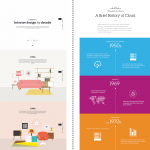Data-Driven UX Design: Leveraging AI for User-Centric Solutions
AI has revolutionized the way the world looks at technology by providing magnificent prospects of growth that push humans to constantly upgrade and adapt to this innovative change. With the advent of AI automated processes, AI has become a crucial component for businesses as it plays a huge role in improving customer experience. As AI is reshaping how we use technology, there is a need to restructure our user experience and create more personalized products and content for better business outcomes. Therefore, the role of a UX designer is becoming more instrumental in creating user-centric solutions.
UX designers can incorporate effective strategies and provide customer-focused solutions with the help of learning programs like UX design boot camps, which can exponentially improve brand reputation. Customer engagement is paramount when strategizing for an enhanced user experience. Forbes has identified customer analytics such as social media, customer engagement, and customer acquisition analytics that help in understanding the needs of the target users.

Image Credit Freepik
The integration of AI in UX design has enabled designers to predict user behaviors, which has ultimately led to delivering a holistic experience to the users. Artificial intelligence can be used by UX designers for enhanced efficiency and greatly improved customer service. For example, a study by Unbounce shows how AI analytics can analyze historical user behavior to get an in-depth insight into their online patterns and provide an optimal user experience.
AI can be leveraged in UX to deliver industry-leading measures in customer servicing. Some benefits of combining AI with UX are given below:
Personalization: A Zendesk report says that 76% of users want brands to include personalization. AI can play a vital role in providing a personalized experience to users by learning from their behavior and interests, which will ultimately help in customer engagement and drive revenue in the bigger picture. For example, a Harvard study shows how Pinterest uses AI to record users’ online behavior and interactions and suggests new pins on the basis of that.
Predictive modeling: AI plays a huge role in providing a customizable experience to users by recommending content according to their preferences and needs. This predictive behavior helps in improving businesses’ marketing and sales strategies as it helps to retain their customer base. An article by Engati showcases how Netflix uses predictive user behavior and predicts recommendations based on users’ past viewing experience.
Adaptive learning: AI can create adaptive interfaces that learn from users’ preferences and adapt to the users’ needs over time. This can help in optimizing business processes by continually polishing their design interfaces. An article published by the Marketing Intelligence Institute studies how Spotify uses AI to personalize playlists and recommendations by studying users’ listening behavior.
Customer satisfaction has become crucial in determining the success of any business. Leveraging AI in UX design can help a UX designer to be on par with the evolving taste of customers, resulting in better business decisions. Using AI and making the right data-informed decisions can result in customer loyalty and growth in a business.
Let us dive into some techniques that help UX designers harness the power of data by incorporating AI in their design process.
Chatbots: The use of chatbots can help in engaging customers in a real-time conversation and answer FAQs (Frequently Asked Questions). AI chatbots also learn from previous interactions and offer customized interaction for every customer. This can help in building a one-to-one relationship with customers and imbibing a sense of credibility in them.
Sentiment Analysis: Companies have myriad sources of gauging customer choices and sensibility like online reviews, social media comments, emails, etc. Sentiment analysis helps a business to analyze the emotional tone of any user’s online engagement. This can help in understanding users’ sentiment and identifying areas of improvement to work on issues proactively.
Intelligent Routing: Intelligent routing can streamline the processes of a business by routing the customers to the right person to cater to their needs. This helps in reducing the wait time and better time management in terms of business.
Other techniques like Voice Recognition and Natural Language Processing, virtual assistants for self-service, and efficient email and text management can also be helpful for a UX designer to help identify the latest trends and transform design decisions.
User experience is the most crucial element to consider while running a business. Understanding/not understanding your customers’ needs and preferences can have a direct impact on your business.
AI has increased capabilities to help UX designers. As reiterated earlier, using personalization to create user-centric solutions can help create a meaningful and relevant experience for any user. From the perspective of any business, it is even more important to watch out for the evolving needs of a consumer. There are many strategies that can help a UX designer to create user-centric solutions by leveraging AI.
Know the customer and analyze their behavioral patterns
By constantly learning from user interactions, content can be tailored in alignment to users’ interest. Research data and surveys can help gather common trends to get an insight into customer behavior. It is important to have a clear understanding of the customers by using relevant machine-learning algorithms to build a product that will suit them in the long run.
Identify areas of personalization
AI adapts to user behavior and preferences and provides a personalized experience to every user. Learning from a user’s past shopping and browsing history can be beneficial for a business in order to provide relevant information on their feed.
An article from McKinsey and Company shows how Amazon provides a personalized shopping experience by recommending products that would go best with the ones already in cart. From a business standpoint, personalization powered by AI can lead to increased customer satisfaction and retention as it will reduce search time and make it easier for users to get information based on their needs, resulting in higher revenue.
A/B Testing
A/B testing (also known as split testing/bucket testing) is a method of UX research that is used to compare two versions of a variant to conclude which one performs better.
It is important to ensure that a UX designer is moving in the right direction and using testing methods like A/B can help a UX designer assure if his/her approach to personalization is effective or not. Based on the result, the UX designer can tweak design decisions for future.
Ethical considerations
As important as it is to analyze user behavior for a business, respecting user privacy is essential as well. Make sure that users’ consent is prioritized for analyzing any personal data. Users appreciate transparency and it is the responsibility of a UX designer to respect their privacy without discriminating them against any group of people.
AI + UX design is a powerful methodology to create a dynamic digital landscape. With personalizing experience that resonates with the changing needs of the user, AI can create user experiences that are beneficial to the customer as well as to a growing business.
Chatbots, virtual assistants, predictive modeling are few of the examples where the blend of AI with UX will not only create a user-centric experience, but will help UX as an industry to grow, learn, rectify, and implement these changes and create an environment that is meaningful to both customers and the UX designers. Focusing on user-centric behavior will reshape the whole idea of online engagement and set new possibilities for the future, which are ever-evolving.
Cover Image by Freepik















